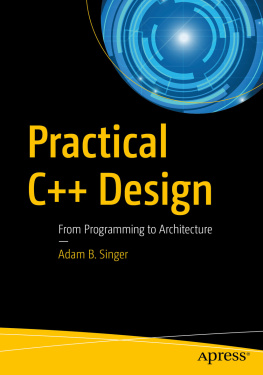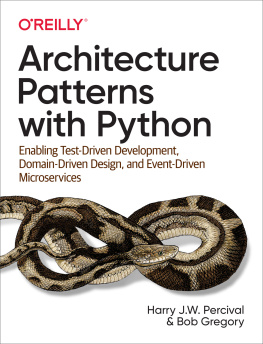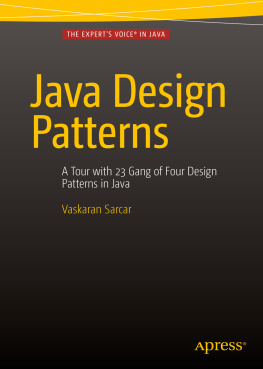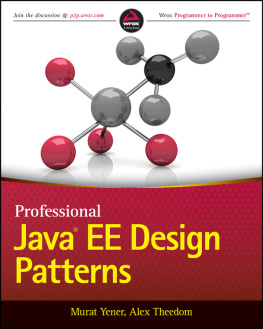1. Defining the Case Study
1.1 A Brief Introduction
This book is about programming design. However, unlike many books on this topic, this book teaches design by exploration rather than design by instruction. Typically, most authors writing about some aspect of design establish principles they wish to convey, lay out these principles in the abstract, and then proceed to give examples supporting the current points. This is not such a book. Rather, this book defines a practical problem to be solved, and proceeds to examine its solution in detail. That is, instead of deciding on a topic and creating trivial examples to support its teaching, I have defined a hard problem and then let the solution of this problem dictate what topics should be discussed.
Interestingly enough, the above approach is exactly how I would tell someone not to learn a subject. I always stress that people should learn broad fundamentals first and subsequently apply these principles to solving problems. However, this is not a book meant to teach the principles of design. Rather, this is a book meant for someone who already knows the fundamentals but wishes to deepen his knowledge of practice. This is a book meant to teach someone the craft of designing and implementing a realistic, albeit small, program from start to finish. This process involves more than knowing elements of design. It involves understanding when and how to use what you know, understanding how to decide between seemingly equivalent approaches, and understanding the long-term implications of various decisions. This book is not comprehensive in its coverage of data structures , algorithms, design patterns, or C++ best practices; volumes of books exist to cover these topics. This is a book about learning how to apply this knowledge to write code that is organized, cohesive, sensible, purposeful, and pragmatic. In other words, this book is about learning to write code that both gets the job done now (development) and allows others to continue to get the job done in the future (maintenance). This, I have termed practical design .
In order to explore practical design, we need a case study. Ideally, the case study problem should be
Large enough to be more than trivial,
Small enough to be tractable,
Familiar enough to not require domain specific expertise, and
Interesting enough to maintain the readers attention for the duration of the book.
After taking the above criteria into consideration, I decided to select a stack-based, Reverse Polish Notation (RPN) calculator as the case study. The details of the calculators requirements will be defined below. I believe that the code for a fully functioning calculator is significant enough that the detailed study of its design provides sufficient material to cover a book. Yet, the project is small enough that the book can be a reasonable length. Certainly, specialized domain expertise is not required. I suspect every reader of this book has used a calculator and is well-versed in its basic functionality. Finally, I hope that making the calculator RPN provides a suitable twist to stave off boredom.
1.2 A Few Words About Requirements
No matter how big or how small, all programs have requirements. Requirements are those features, whether explicit or implicit, to which the program must comply. Entire books have been written on gathering and managing software requirements (see, for example, [28] or [21]). Typically, despite ones best efforts, it is practically impossible to gather all of the requirements upfront. Sometimes, the effort required is economically infeasible. Sometimes, domain experts overlook what seem like obvious requirements to them, and they simply neglect to relate all of their requirements to the development team. Sometimes, requirements only become apparent after the program begins to take shape. Sometimes, the customer does not understand his or her own requirements well enough to articulate them to the development team. While some of these dilemmas may be mitigated using agile development methods, the fact remains that many design decisions, some of which may have far reaching implications, must occur before all of the requirements are known.
In this book, you will not study techniques for gathering requirements; rather, the requirements are simply given upfront. Well, most of them will be given upfront. A few of the requirements have been explicitly reserved until a later chapter so that you can study how your design might change to accommodate unknown future expansion. Certainly, one could justly argue that since the author knows how the requirements will change, the initial design will correctly predict the unforeseen features. While this criticism is fair, I nonetheless argue that the thought process and discussion behind the design decisions is still relevant. As a software architect, part of your job will be to anticipate future requests. Although any request is possible, incorporating too much flexibility at the outset is not economical. Designing for future expansion must always be considered as a tradeoff between the cost difference for expressly accommodating expandability upfront versus modifying the code later if a change is requested. Where a design should land in the spectrum between simplicity and flexibility must ultimately be measured against the likelihood of a feature request materializing and the feasibility of adding a new feature if its incorporation is not considered at the beginning.
1.3 Reverse Polish Notation
I presume that anyone reading this book is familiar with the typical operation of a calculator. However, unless you grew up using a Hewlett Packard calculator, you may be unfamiliar with how a stack-based RPN calculator functions (see [5] if you are unfamiliar with how a stack works). Simply stated, input numbers are pushed onto a stack, and operations are performed on the numbers already on the stack. A binary operator, such as addition, pops the top two numbers from the stack, adds the two numbers, and then pushes the result onto the stack. A unary operator, such as the sine function, pops one number from the top of the stack, uses this number as the operand, and pushes the result onto the stack. For those familiar with basic compiler lingo, RPN functions as the postfix notation of the operation (see [1] for a detailed discussion of postfix notation). The following list describes my opinion of just a few of the advantages of Reverse Polish Notation over conventional syntax:
All operations can be expressed parentheses free.
Multiple inputs and outputs can be visualized simultaneously.
Large calculations can be trivially decomposed into multiple, simple operations.
Intermediate results can be trivially retained and reused.
While RPN will likely seem incredibly awkward at first, once youve become accustomed to it, you will curse every calculator that does not employ it when you are tasked with performing anything more complicated than simple arithmetic.
To ensure that the operation of an RPN calculator is clear, lets examine a short example. Suppose we wish to evaluate the following expression:
On a typical, non-RPN calculator, we would type ((4 + 7) * 3 + 2) / 7 and then press the = key. On an RPN calculator, we would instead type 4 7 + 3 * 2 + 7 / , where there is an enter command following each number in order to push the input onto the stack. Note that for many calculators , to reduce key entry, operations such as + may also function to implicitly enter the previous number on the stack. Figure shows the above calculation performed step-by-step on an RPN calculator.











